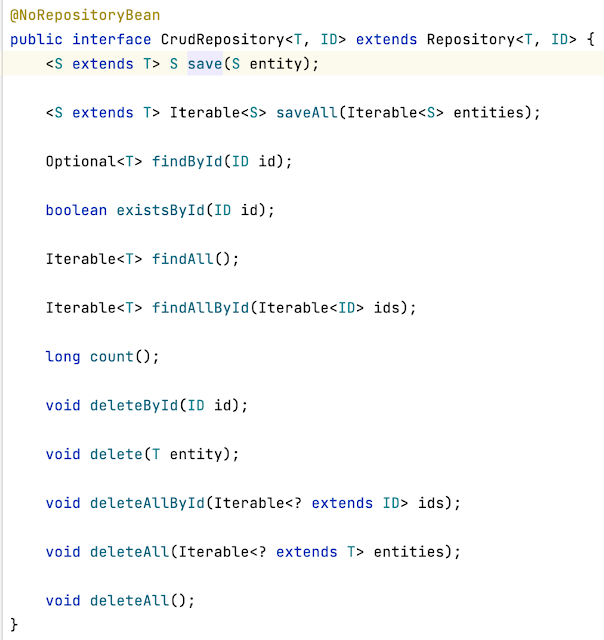Spring Data JPA CrudRepository - saveAll() Method
In this tutorial, we will learn how to use the Spring Data CrudRepository
interface provided the saveAll()
method with an example.
saveAll() Method Overview
As the name depicts, the saveAll() method allows us to save multiple
entities to the DB.
It belongs to the CrudRepository interface defined by Spring Data.
The saveAll() method returns a list of Iterable objects.

Maven Dependencies
Add the following maven dependencies to your Spring Boot project:
<dependency>
<groupId>org.springframework.boot</groupId>
<artifactId>spring-boot-starter-data-jpa</artifactId>
</dependency>
<dependency>
<groupId>com.mysql</groupId>
<artifactId>mysql-connector-j</artifactId>
<scope>runtime</scope>
</dependency>
Product Entity
Let's first create a Product entity that we are going to save into the database using the save() method:
package net.javaguides.springdatajpacourse.entity;
import org.hibernate.annotations.CreationTimestamp;
import org.hibernate.annotations.UpdateTimestamp;
import jakarta.persistence.*;
import java.math.BigDecimal;
import java.util.Date;
@Entity
@Table(name="products")
public class Product {
@Id
@GeneratedValue(strategy = GenerationType.IDENTITY)
@Column(name = "id")
private Long id;
@Column(name = "sku")
private String sku;
@Column(name = "name")
private String name;
@Column(name = "description")
private String description;
@Column(name = "price")
private BigDecimal price;
@Column(name = "image_url")
private String imageUrl;
@Column(name = "active")
private boolean active;
@Column(name = "date_created")
@CreationTimestamp
private Date dateCreated;
@Column(name = "last_updated")
@UpdateTimestamp
private Date lastUpdated;
public Long getId() {
return id;
}
public void setId(Long id) {
this.id = id;
}
public String getSku() {
return sku;
}
public void setSku(String sku) {
this.sku = sku;
}
public String getName() {
return name;
}
public void setName(String name) {
this.name = name;
}
public String getDescription() {
return description;
}
public void setDescription(String description) {
this.description = description;
}
public BigDecimal getPrice() {
return price;
}
public void setPrice(BigDecimal price) {
this.price = price;
}
public String getImageUrl() {
return imageUrl;
}
public void setImageUrl(String imageUrl) {
this.imageUrl = imageUrl;
}
public boolean isActive() {
return active;
}
public void setActive(boolean active) {
this.active = active;
}
public Date getDateCreated() {
return dateCreated;
}
public void setDateCreated(Date dateCreated) {
this.dateCreated = dateCreated;
}
public Date getLastUpdated() {
return lastUpdated;
}
public void setLastUpdated(Date lastUpdated) {
this.lastUpdated = lastUpdated;
}
@Override
public String toString() {
return "Product{" +
"id=" + id +
", sku='" + sku + '\'' +
", name='" + name + '\'' +
", description='" + description + '\'' +
", price=" + price +
", imageUrl='" + imageUrl + '\'' +
", active=" + active +
", dateCreated=" + dateCreated +
", lastUpdated=" + lastUpdated +
'}';
}
}
ProductRepository
Let's create ProductRepository which extends the CrudRepository interface.
As we know that CrudRepository
interface provides the saveAll() method so our ProductRepository interface
should extend to the
CrudRepository interface to get all its methods:
import net.javaguides.springdatajpacourse.entity.Product;
import org.springframework.data.repository.CrudRepository;
public interface ProductRepository extends CrudRepository<Product, Long> {
}
Configure MySQL and Hibernate Properties
Let's use the MySQL database to store and retrieve the data in this example and we gonna use Hibernate properties to create and drop tables.
Open the application.properties file and add the following configuration to
it:
spring.datasource.url=jdbc:mysql://localhost:3306/ecommerce?useSSL=false
spring.datasource.username=root
spring.datasource.password=Mysql@123
spring.jpa.properties.hibernate.dialect = org.hibernate.dialect.MySQLDialect
spring.jpa.hibernate.ddl-auto = create-drop
spring.jpa.show-sql=true
spring.jpa.properties.hibernate.format_sql=true
Make sure that you will create ecommerce database before running the Spring boot application. Also, change the MySQL username and password as per your MySQL installation on your machine.
In order to test the saveAll() method, we gonna use CommandLineRunner.run() method to execute the testing
code while the Spring boot application startup:
import net.javaguides.springdatajpacourse.entity.Product;
import net.javaguides.springdatajpacourse.repository.ProductRepository;
import org.springframework.beans.factory.annotation.Autowired;
import org.springframework.boot.CommandLineRunner;
import org.springframework.boot.SpringApplication;
import org.springframework.boot.autoconfigure.SpringBootApplication;
import java.math.BigDecimal;
import java.util.Date;
import java.util.List;
@SpringBootApplication
public class SpringDataJpaCourseApplication implements CommandLineRunner{
public static void main(String[] args) throws Exception {
SpringApplication.run(SpringDataJpaCourseApplication.class, args);
}
@Autowired
private ProductRepository productRepository;
@Override
public void run(String... args) throws Exception {
Product product = new Product();
product.setName("product 1");
product.setDescription("product 1 desc");
product.setPrice(new BigDecimal(100));
product.setDateCreated(new Date());
product.setLastUpdated(new Date());
product.setSku("product 1 sku");
product.setActive(true);
product.setImageUrl("product1.png");
Product product2 = new Product();
product2.setName("product 2");
product2.setDescription("product 2 desc");
product2.setPrice(new BigDecimal(200));
product2.setDateCreated(new Date());
product2.setLastUpdated(new Date());
product2.setSku("product 2 sku");
product2.setActive(true);
product2.setImageUrl("product2.png");
// save multiple products at once
productRepository.saveAll(List.of(product, product2));
}
}
After finished Spring boot application runs, you can able to see Hibernate generate two INSERT SQL statements in a console:
Hibernate:
insert
into
products
(active, date_created, description, image_url, last_updated, name, price, sku)
values
(?, ?, ?, ?, ?, ?, ?, ?)
Hibernate:
insert
into
products
(active, date_created, description, image_url, last_updated, name, price, sku)
values
(?, ?, ?, ?, ?, ?, ?, ?)
Note that there are two INSERT SQL statements.